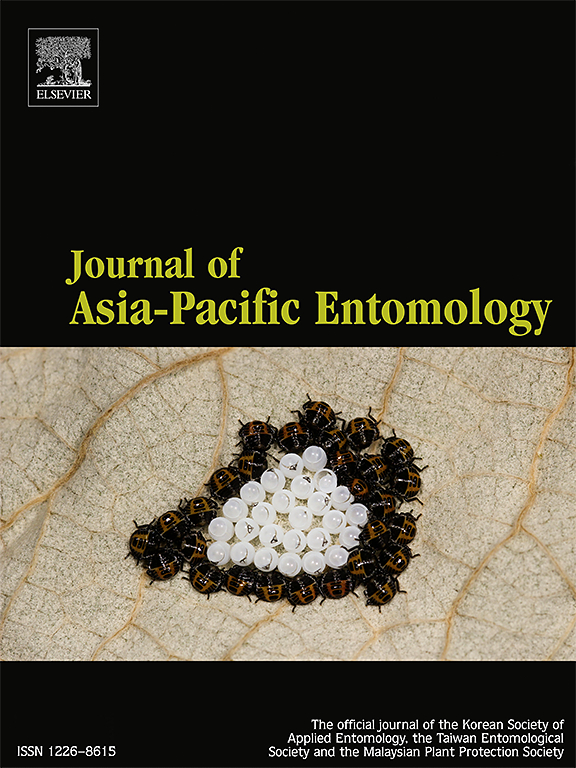Polyadenylate-binding proteins are essential for the molting development of locusts
IF 1.3
3区 农林科学
Q3 ENTOMOLOGY
引用次数: 0
Abstract
Polyadenylate-binding proteins (PABPs) are critical for mRNA stability, translation, and decay in eukaryotes. However, their specific roles in regulating molt-related gene stability in insects remain unclear. Here, we characterize two PABP genes, LmPABP1 and LmPABP2, in the migratory locust, Locusta migratoria. Phylogenetic analysis revealed LmPABP1 as a cytoplasmic PABP (PABPC) and LmPABP2 as a nuclear PABP (PABPN). Tissue-specific expression profiling showed that LmPABP1 is highly expressed in the integument and gut during the fifth instar, while LmPABP2 expression exhibits stage-specific fluctuations. RNA interference-mediated knockdown of LmPABP1 caused 100% mortality in both fourth- and fifth-instar nymphs, whereas silencing LmPABP2 led to varied mortality during pre-, mid-, and post-molting stages. Histological analysis showed disrupted cuticle dissolution in LmPABP1-silenced locusts and delayed dissolution in LmPABP2-depleted individuals. Critically, LmPABP1 knockdown significantly downregulated key chitin metabolism genes (LmCht5, LmCht10, and LmUAP1). Furthermore, actinomycin D treatment confirmed that LmPABP1 silencing accelerates decay of LmCht5 and LmCht10 mRNAs, indicating its essential role in mRNA stabilization. This study delineates the functional divergence of cytoplasmic LmPABP1 and nuclear LmPABP2 in post-transcriptional regulation, specifically stabilizing chitinase mRNAs during locust molting, offering potential molecular targets for developing novel pest control strategies.

聚腺苷酸结合蛋白对蝗虫的蜕皮发育至关重要
聚腺苷酸结合蛋白(PABPs)对真核生物mRNA的稳定性、翻译和衰变至关重要。然而,它们在调节昆虫蜕皮相关基因稳定性中的具体作用尚不清楚。在这里,我们对迁徙蝗虫的两个PABP基因LmPABP1和LmPABP2进行了表征。系统发育分析表明LmPABP1是细胞质PABP (PABPC), LmPABP2是核PABP (PABPN)。组织特异性表达谱显示,LmPABP1在第5龄时在肠管和肠管中高表达,而LmPABP2的表达则呈现阶段性波动。RNA干扰介导的LmPABP1基因敲低可导致4龄和5龄若虫100%的死亡率,而LmPABP2基因沉默可导致脱毛前、脱毛中和脱毛后阶段的死亡率变化。组织学分析显示,lmpabp1沉默的蝗虫的角质层溶解中断,而lmpabp2缺失的蝗虫的角质层溶解延迟。关键的是,LmPABP1敲低显著下调了关键的几丁质代谢基因(LmCht5、LmCht10和LmUAP1)。此外,放线菌素D治疗证实LmPABP1沉默加速了LmCht5和LmCht10 mRNA的衰变,表明其在mRNA稳定中起重要作用。本研究揭示了蝗虫胞质LmPABP1和细胞核LmPABP2在转录后调控中的功能差异,特别是在蝗虫蜕皮过程中稳定几丁质酶mrna,为开发新的害虫防治策略提供了潜在的分子靶点。
本文章由计算机程序翻译,如有差异,请以英文原文为准。
求助全文
约1分钟内获得全文
求助全文
来源期刊

Journal of Asia-pacific Entomology
Agricultural and Biological Sciences-Insect Science
CiteScore
2.70
自引率
6.70%
发文量
152
审稿时长
69 days
期刊介绍:
The journal publishes original research papers, review articles and short communications in the basic and applied area concerning insects, mites or other arthropods and nematodes of economic importance in agriculture, forestry, industry, human and animal health, and natural resource and environment management, and is the official journal of the Korean Society of Applied Entomology and the Taiwan Entomological Society.
 求助内容:
求助内容: 应助结果提醒方式:
应助结果提醒方式:


